Highlights of Slope Soaring event
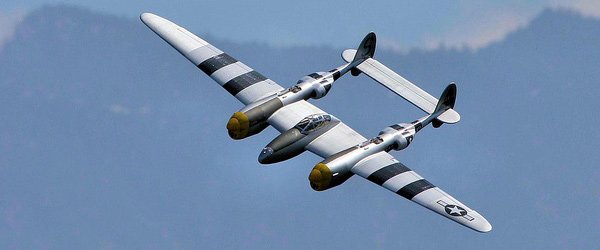
Written by Dave Garwood As featured on page 100 in the December 2011 issue.
GUEST WRITER Joe Chovan contributed this report covering the 2011 Island Slope Rebels (ISR) Spring Power Scale Soaring (PSS) Festival at Cajon Summit.
Once again, Slope Soaring aficionados converged in southern California on Memorial Day weekend to participate in the biennial ISR Spring PSS Festival, sponsored by the Inland Slope Rebels.
In Power Scale Soaring (PSS), hobbyists model and fly aircraft that have full-scale powered airplane counterparts, but are flown in Slope lift as RC model gliders. PSS is popular with Slope Soaring pilots for several reasons including the variety, appearance, and performance available from these models.
In recent years, interest for this event was built primarily in the online forum RCGroups, which has several threads devoted to it.
The main topic thread often sees action in the months prior to the event date, with hopeful participants airing details, pictures, and videos of their models and associated construction techniques. This online community has grown to a worldwide forum and this year’s event drew participants from as far as New York, Hawaii, and New Zealand.
In previous years there have been club projects in which a particular airplane is chosen to be modeled by several participants. This year we enjoyed “Project Spitfire” with more than 20 Supermarine Spitfires being built from identical short kits.
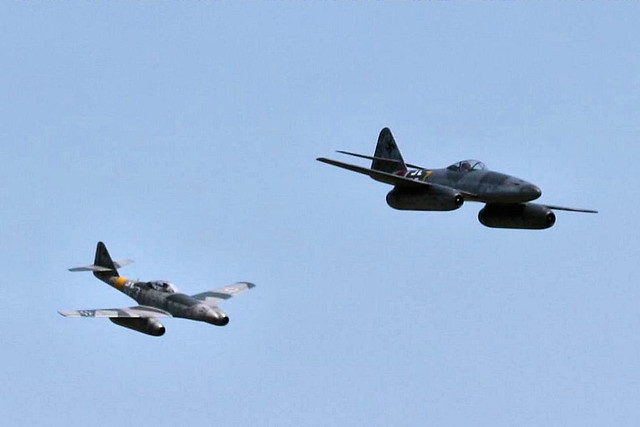
Carl Maas and Brian Laird fly their 54-inch span Me-262s in formation. Getting the airplanes this close when the lift is good is challenging.
The Spitfire project was spearheaded by RC hobbyists in the San Diego area. Master modelers, Brian Laird and Joe Cormier, aided builders with supplies and knowledge. At one point during the event, 13 or more Spitfires flew in formation—an incredible sight to behold and thrilling to perform.
The unofficial start of the event was on Thursday and early arrivals met at the famed Point Fermin in Palos Verdes, California. The atmosphere at the sea cliff overlooking the Pacific Ocean provided a venue to swap stories of Slope Soaring adventures and previous festivals, while experienced fliers enjoyed the good lift.
Point Fermin is one of those magic places that seem impossible to fly with heavy airplanes, until you actually witness your first demonstration. I have many magical memories of previous visits to Point Fermin, but I’ll never forget Ian Gittins’ 100-ounce Rodent smoking up the half-pipes for all to see—proving the lift was good.
On Friday the action moved to the prime location—the Cajon Summit near Hesperia, California, where excellent lift is often found. It’s not possible to encounter crosswind conditions in this giant mountain bowl overlooking Interstate 15. If the air is moving, it is either traveling up or down the slope.
Because the Mojave Desert is behind the hill, daily solar heating yields strong convection currents rising over the desert, causing surface air currents to “suck” through the surrounding mountain passes, including Cajon. So, most sunny days give excellent lift and “big sky” flying may be enjoyed.
The ISR provided a hilltop parking area as well as several places to display models. The flying took place between two sites roughly 1/8-mile apart—the upper and lower hills. The upper hill is best suited for slower airplanes, while the lower hill allows easier landings for the heavier, faster aircraft.
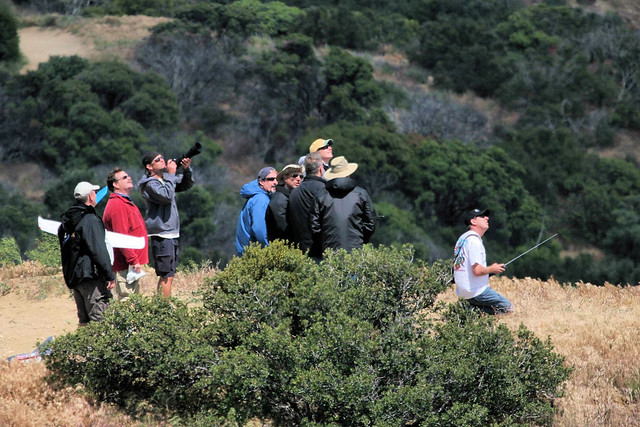
Brian Laird routinely sits while flies. Here, he demonstrates his new creation while onlookers marvel at his prowess.
Fliers read the air by seeing what was being flown and assessing the conditions at each hill. Those unsure of the best course consulted local experts, Carl Maas and Brian Laird. One request often heard was, “Brian, can you land my plane?”
I flew often and early on Friday, and in one instance collided with Dan Cummings, who cheerfully remarked, “There is a way we can guarantee we won’t have any midairs: We go sit in our cars and don’t fly. But that isn’t why we’re here!” I agreed and we resumed immediately.
Airplanes like ours are built stoutly enough to survive contact and a little paint-swapping is simply the price of admission for a weekend of fun.
This type of Slope flying requires advanced awareness, and to the casual observer it is amazing how fliers keep track of their own airplanes amidst all the action. It offers the “off-the-scale cool factor,” illustrated each year when motocross riders traversing the trail near the flying site stop to watch the spectacle.
The highlight for many is the mandatory Slope Scale party in which five to 10 or more pilots perform half-pipe formation flights, turning in unison with stall turns on each edge of the flight window between dives approaching 100 mph or more. Nearly everyone who could fly Friday did, and I recall leaving the hill reluctantly, although craving a meal and shower.
The lift was excellent again on Saturday. We had hoped Bill Kenny would fly his 100-inch span, 55-pound Douglas SBD-3 Dauntless, but technical difficulties kept him grounded. Bill’s airplane was one of the most astounding creations ever made for a PSS Fest. The level of detail is high and craftsmanship is simply top-notch. When viewing the airplane for the first time, one can only think, “And you say you’re going to throw this off a cliff?” See the Web link listed in the “Sources” for a chronicle on Bill’s 2½-year build process.
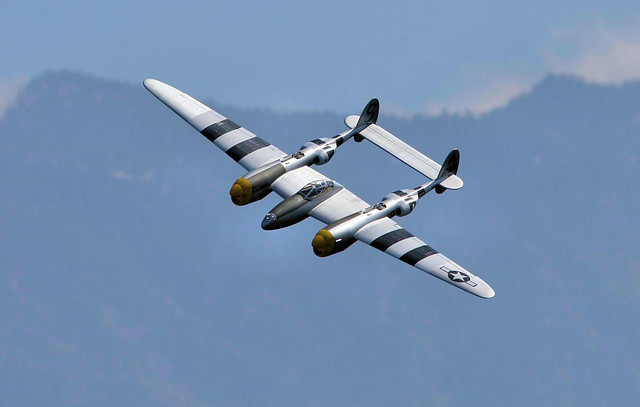
The maiden flight of Phil Herrington’s P-38 went off without a hitch. The airplane epitomizes amazing craftsmanship and dedication in PSS Slope Soaring..

Ian Gittins launches Phil Herrington’s 108-inch wingspan, 19-pound Lockheed P-38 Lightning original-design PSS Slope Sailplane.
Phil Herrington grabbed the limelight with his giant Lockheed P-38 Lightning. Phil built the airplane for Soar Utah the previous year, but was unable to fly. The maiden flight proved worth the wait as he flew for more than 30 minutes to the delight of all who saw his accomplishment. Phil’s 108-inch span P-38 weighs 19 pounds with a wing area of 1,310 square inches, giving a wing loading of 33.4 ounces per square foot.
Also noteworthy were David “Nauga” Hyde’s Sea Hawk and original scratch-built S-3 Viking. The 60-inch span, 100-ounce Viking features exact scale dimensions—nothing is stretched (to perhaps give better flight performance), and has homemade decals and paint masks, Sharpie panel lines, airbrush, and artists’ charcoal weathering. It uses two channels, three-servo flaperons, and elevator.

Nauga” Hyde’s original scratch-built S-3 Viking was finished for the 2009 festival, but did not fly until this year.
His Sea Hawk started as a Russ Thompson Meteor fuselage molded in polyester, glass, and carbon fiber. It has a 60-inch span, weighs 4 pounds, 13 ounces, for a 28-ounce-per-square-foot wing loading. “It’s a rocket,” says Dave, who flew it near the end of the day when most of the other heavy airplanes had landed.
The contest is judged strictly by rules governing craftsmanship as they pertain to Scale modeling and is largely a “beauty contest.” But all the airplanes are built with goals to fly and fly well. These airplanes look and perform great. Judging these marvelous Scale models is often a daunting task but is performed under the expert guidance of master craftsman Carl Maas Sr.
Carl says the level of craftsmanship has steadily risen, and has reached an amazing mark with this year’s entries. Participating and flying one’s own creation in one of the longest-running premiere Slope events worldwide, gives a sense of accomplishment.
Saturday evening, the fliers left the hill to go to a local eatery for a thorough recap of the day’s events. More than 50 pilots flew hundreds of sorties and the camaraderie was as thick as a brotherhood can be. This largely online community met with purpose and celebrated in style one of the most rewarding pursuits in RC flight.
By keeping in touch throughout the year, looking forward to this event, and building (often from scratch) your sleek creation to join the action over such majestic vistas, you know you’re in great company.
The wind blew all night and expectations were high for Sunday, but alas a repeat of Saturday’s conditions was not in the cards. Early risers met on the hill to witness light wind blowing down the slope. Several participants chose to leave early perhaps to fly other venues on the trek home. I was happy to get a jump on the holiday weekend traffic, and started my drive home with memories of great friends and flying.
Most agreed it was a fun festival—among the best in recent memory—despite lack of flying on Sunday. There was plenty of inspiration to fuel the desire for the next PSS Fest in 2013.
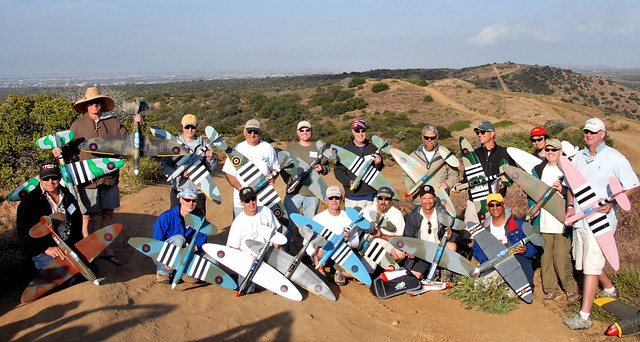
Project Spitfire was spearheaded by a group of San Diego-area fliers. Participants built and flew more than a dozen Spitfires at the PSS festival.
| 2011 Southern California PSS Festival Awards |
|
Foamie: 1. Phil “Slopeboulder” Herrington - Lockheed P2V Neptune 2. David “Nauga” Hyde - Beechcraft T-34C Mentor 3. Fabio “Slopeaddict” Marin - Supermarine Spitfire 4. Dale “He4gott” Gottdank - Beechcraft Model 17 Staggerwing 5. Tony “Skiiibear” Jaworowski - North American P-51 Mustang Civilian Aircraft: 1. David “Nauga” Hyde - Piaggio Avanti 2. Rick “Schwemmer” Schwemmer - Bede BD-5 “Coors Light” Jet 3. Sean “I’m Rick James” Galt - Gloster Meteor 4. Carl “Carlski” Maas Jr. - Cirrus Vision 5. Scott “Sarmoby” Rogers - Cirrus Vision Jet Military Aircraft: 1. Carl “Carlski” Maas Jr. - Messerschmitt Me 262 Swallow 2. Russ “Slopeiron” Thompson - Focke-Wulf Fw P.I 3. David “Nauga” Hyde - Hawker Sea Hawk 4. Ken “Kenracer” Long - McDonnel/Douglas F-18 Hornet 5. Dave “Tick Point” Munson - Northrop X-4 Bantam Propeller Military Aircraft: 1. Bill “MicroRotors” Kenny - Douglas SBD-3 Dauntless 2. Phil “Slopeboulder” Herrington - Lockheed P-38 Lightning 3. Brian “TFLG” Laird - Grumman F8F Bearcat 4. Joe “Joemach1” Cormier - Mitsubishi A6M2 Zero 5. Bill DelHagen - Supermarine Spitfire Mk 19 Outstanding Craftsmanship: Bill “MicroRotors” Kenny - Douglas SBD-3 Dauntless Phil “Slopeboulder” Herrington - Lockheed P-38 Lightning Best of Show: Bill “MicroRotors” Kenny - Douglas SBD-3 Dauntless Farthest Traveler Award: Jordan “Hamburglar” Smith - Australia Sponsors: Inland Slope Rebels Leading Edge Gliders House of Balsa Inc. Cermark Hobby People Hitec Reese Productions MSM Industries Jart Designs Soaring USA Tower Hobbies R/C Flyer Model Airplane News Bob Smith Industries Joe Cormier Lars Berg Marty Hill Great Planes Model Manufacturing |
2011 PSS Spitfire—San Diego build
www.rcgroups.com/forums/showthread.php?t=1333591
Bill Kenny’s Ziroli Dauntless PSS build thread
www.rcgroups.com/forums/showthread.php?t=992515
Dave Hyde’s S-3 Viking build thread
www.rcgroups.com/forums/showthread.php?t=804631
League of Silent Flight
www.silentflight.org
Inland Slope Rebels
www.inlandsloperebels.com










Add new comment